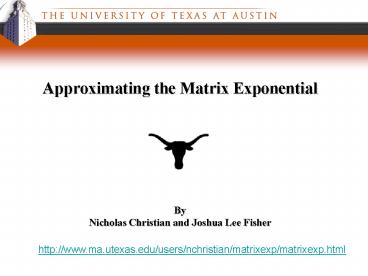Approximating the Matrix Exponential - PowerPoint PPT Presentation
1 / 12
Title:
Approximating the Matrix Exponential
Description:
Multistep (Adams-Bashforth-Moulton) Adjustable order predictor ... Closed Adams-Moulton implicit formula (Corrector) Adaptable time step improves the accuracy ... – PowerPoint PPT presentation
Number of Views:117
Avg rating:3.0/5.0
Title: Approximating the Matrix Exponential
1
Approximating the Matrix Exponential
By Nicholas Christian and Joshua Lee Fisher
http//www.ma.utexas.edu/users/nchristian/matrixex
p/matrixexp.html
2
Goal
- Examine the accuracy and efficiency of methods
for - computing eA, where A is a nn matrix.
- Evaluation of two types of matrices positive
definite - and symmetric.
- We formally define eA by the series expansion,
3
Methods
- Truncated Series Methods
- Truncated Taylor Series
- Padé Approximation
- Scaling and Squaring
- Ordinary Differential Equation (ODE) Methods
- General Purpose ODE Solver (Runge-Kutta-Fehlberg)
- Stiff Solver (R-K 3rd order solution 2nd order
accurate) - Multistep (Adams-Bashforth-Multon)
4
Truncated Series Methods
- Truncated Taylor Series
- The accuracy decreases and the time efficiency
increases as A increases. - Padé Approximation
- The Padé Approximation is very accurate when
A lt 1 - The loss of accuracy with these series is not the
truncation, but the round off error from
calculating the terms.
5
Truncated Series Methods (continued)
- Scaling and Squaring
- Find the smallest power of 2 such that A lt 1
- Then compute e(A/n)
- Next form e A be repeatedly squaring e(A/n)
- By reducing the norm of the matrix, Scaling and
Squaring improves the accuracy of any method.
6
ODE Methods
- Motivation
- Linear first order constant coefficient ordinary
differential equation, - where A is a nn constant coefficient matrix
and x(t) is a n1 function vector with respect to
t. - Initial conditions are the jth column of the
identity matrix I. - Using seperation of variables, the solution to
the evolution equation is - Therefore when t 1 we obtain the desired
calculation,
7
ODE Methods(continued)
- General Purpose ODE Solver
- Fifth order solution with fourth order accuracy
- Adaptable time step Runge-Kutta-Fehlberg
- Low order Stiff Solver
- Third order solution with second order accuracy
- Adaptable time step Runge-Kutta
- Multistep (Adams-Bashforth-Moulton)
- Adjustable order predictor-corrector method
- Fixed time step
- Open Adams-Bashforth explicit formula (Predictor)
- Closed Adams-Moulton implicit formula (Corrector)
- Adaptable time step improves the accuracy
- Stiff solver is the slowest
8
Results Positive definite m50
x 10-3
x 10-9
Legend Taylor (blue), Padé (red), R-K-45(green),
R-K-23(black), A-B-M (cyan).
9
Results Symmetric m50
Legend Taylor (blue), Padé (red), R-K-45(green),
R-K-23(black), A-B-M (cyan).
10
Conclusion
- Series and ODE methods give more accurate results
and are more time efficient for positive definite
matrices. - A clear example is Padé Approximation
- Runge-Kutta-Fehlberg method had average
performance in accuracy and efficiency for both
types of matrices. - The stiff solver gave accurate results, however
had the longest computation time. Taking up to
30 sec. for the m50 symmetric case and over 5
min. in the m100 symmetric case. - Taylor series consistently gave good accuracy and
increasing calculation time. However as A
increases, Taylor gives less accurate results.
11
References
12
References(continued)































